Techniques for Identifying Crystals Through Observation
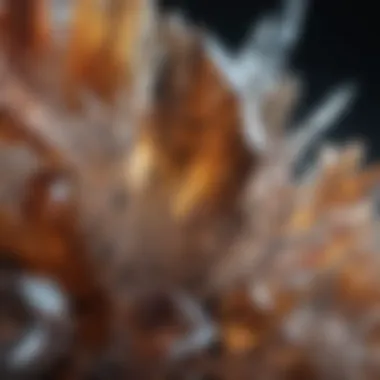
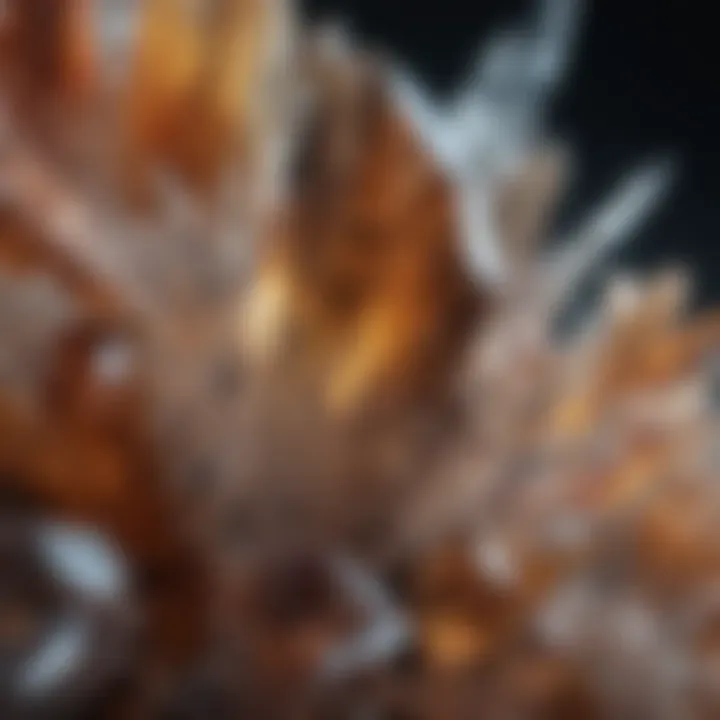
Intro
The world of crystals is nothing short of fascinating. With their diverse shapes, colors, and structures, these natural wonders have captivated collectors and enthusiasts alike. Understanding how to identify crystals through visual means opens a door to a greater appreciation of geology and mineralogy. This article dives deep into the methods that can enhance your identified prowess, whether you are sorting through a collection of unique specimens or simply enjoying nature's beauty.
Visual identification of crystals rests on several physical characteristics. It's not just about recognizing familiar forms; it's about discerning subtle nuances. Factors such as color, luster, and transparency play pivotal roles. As an enthusiast, honing these skills will enrich your experience, enabling you to connect more profoundly with each crystal you encounter.
Whether you are new to the hobby or have an extensive collection, this guide aims to equip you. We will delve into crucial techniques, explore classification systems, and provide resources to enhance your crystalline knowledge. By the end, you will be more adept at identifying crystals and appreciating their intricate beauty.
Featured Collectible of the Month
Overview
This month, we shine a spotlight on the stunning Amethyst. Renowned for its deep, rich purple hue, Amethyst is a beloved crystal among collectors. The color can range from a light lavender to a dark, nearly black shade. Found abundantly in countries like Brazil and Uruguay, this quartz variant carries both aesthetic charm and metaphysical significance.
Historical Significance
Historically, Amethyst has been associated with royalty and spirituality. Ancient Greeks believed it held protective qualities, warding off intoxication and enhancing clarity of mind. The allure of Amethyst stretches back centuries, with artifacts and gems adorning crowns and royal regalia. Understanding its history provides depth to the joy of ownership, as each piece carries stories from the past.
Identification Techniques
Visual Characteristics
To accurately identify crystals, several visual characteristics are essential:
- Color: The first thing most people notice. Each crystal exhibits specific colors that can indicate its type and quality.
- Clarity: Inspect if the crystal is transparent, translucent, or opaque. This can aid in differentiating similar-looking types.
- Luster: Observe the crystal’s surface shine. It can be glassy, dull, or metallic, providing clues to its mineral composition.
- Crystal Habit: Assess the shape of the crystal. Some have cubic forms, while others are elongated or fibrous.
- Inclusions: Tiny imperfections can make unique identifiers. Some crystals, like Quartz, exhibit fascinating inclusions that tell their story.
- Cleavage and Fracture: Understanding how a crystal breaks can be crucial. Cleavage is how it breaks along certain planes, and fracture is the pattern it exhibits otherwise.
Resources for Identification
To further bolster your crystal identification skills, consider the following resources:
- Books: "The Audubon Society Field Guide to North American Rocks and Minerals" is a great start.
- Websites: Websites such as Wikipedia and Britannica have extensive information on minerals and crystals.
- Online Communities: Engaging in platforms like Reddit or Facebook can connect you with enthusiasts ready to share their expertise and experiences.
"The real voyage of discovery consists not in seeking new landscapes, but in having new eyes." - Marcel Proust
Becoming proficient at identifying crystals through visual cues transforms the way you view these natural wonders. Each glance will reveal a world of color, form, and history. As you continue your journey, you'll find the art of crystal identification to be as enriching as the crystals themselves.
Understanding Crystal Identification
Identifying crystals visually is an essential skill for any mineral enthusiast or professional in the fields of geology and mineralogy. This process is not just about understanding what each type looks like, but it involves appreciating the intricate details that set them apart from one another. Visual identification can open up a treasure trove of knowledge about a crystal's properties, origins, and even its potential uses in various applications.
Importance of Visual Identification
Visual identification serves as the initial step in recognizing crystalline structures. It's like putting the pieces of a puzzle together before diving into deeper analysis. One of the key advantages of mastering visual identification is that it equips collectors with the ability to evaluate the authenticity and quality of specimens in their hands. Each aspect – from color variations to surface texture – tells a story that enhances one’s understanding of the mineral world.
Moreover, having a keen eye for identifying crystals visually can save time and resources. Many collectors find themselves drawn to specific minerals without fully grasping their characteristics. With thorough visual identification skills, enthusiasts can sift through rock shops or online marketplaces with greater confidence, ensuring they keep only the most genuine pieces in their collections.
Additionally, the knowledge gained from visual identification nurtures a deeper appreciation for nature. The more one learns about the crystals’ appearance, the more they develop a connection to geological processes that formed them. This connection fosters respect and care for these natural wonders, particularly important in today's context of sustainability and ethical collecting practices.
Crystalline Structures Defined
To understand crystal identification, one must first grasp what a crystalline structure encapsulates. A crystal is not merely a pretty object; it possesses a defined, repetitive arrangement of atoms and molecules. This orderly structure manifests in various shapes and forms, which can be categorized into several crystal systems. These systems—like cubic, tetragonal, and hexagonal—dictate how the crystals grow and how they will appear to the naked eye.
Crystalline structures often reflect their atomic arrangements in highly distinctive visual traits. For instance, a salt crystal will differ vastly in appearance from a quartz crystal, despite both being common in geological formations. An understanding of these structures helps collectors and geologists categorize crystals effectively. Each shape carries significant information: a cubic crystal may suggest specific chemical properties or formation conditions that might differ from those of a hexagonal crystal.
"The more we understand the rules governing crystal structures, the better equipped we are to identify and classify the vast array of minerals around us."
As one delves deeper into crystallography, they unlock layers of information tied to each specimen. Being able to identify these basic crystalline forms, cultivates both knowledge and satisfaction for the collector, fostering an ongoing pursuit of learning within the rocky realms of mineralogy.
Key Physical Characteristics of Crystals
Understanding the key physical characteristics of crystals is essential not just for collectors but for anyone interested in geology and mineralogy. These traits help in recognizing and classifying crystals, which is pivotal when identifying their origins, uses, and value. By grasping these characteristics, enthusiasts can avoid misidentifications and appreciate the unique beauty each crystal offers.
Hardness and its Role
Hardness is a fundamental property that significantly contributes to the identification of crystals. It describes how resistant a material is to scratching. The Mohs scale of mineral hardness rates minerals from 1 (talc) to 10 (diamond), and this scale is invaluable for differentiation.

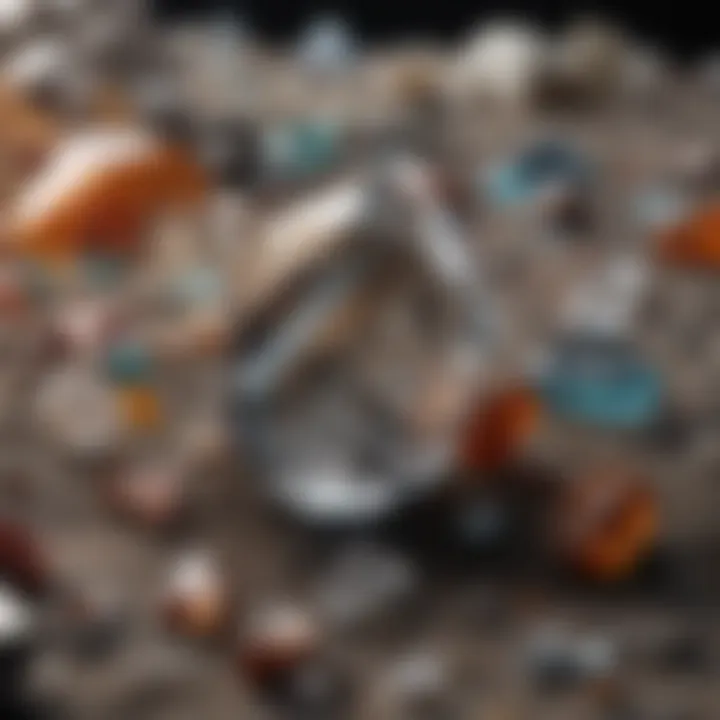
For instance, if a crystal scratches glass, it likely has a hardness greater than 5.5. Conversely, if it gets scratched by a steel nail, it may fall below 6. Some indicatives of hardness can help collectors assess which minerals they're dealing with. Recognizing these relative strengths can save time and trouble in identifying various specimens.
In practical terms, always carry a few hard objects, like a piece of quartz or glass, to use as tests during field trips or collecting excursions. This simple method brings clarity to your explorations.
Lustre: The Glossy Indicator
Lustre determines how light interacts with a crystal's surface, and it plays a crucial role in visual identification. Lustre types can range from metallic to vitreous and pearly, and each offers insight into the mineral's composition.
When you observe a crystal, take note of its shine:
- Metallic lustre: Indicates minerals like pyrite or galena, which are heavy and often have a shiny, reflective quality.
- Vitreous lustre: Common in quartz and feldspar, this glass-like finish can help in distinguishing between different types of items.
- Pearly lustre: Features a soft glow that suggests a layered structure, evident in minerals such as talc or dolomite.
Understanding how to categorize lustre types fosters a more in-depth grasp of crystal features. Engaging with lustre helps refine visual skills vital to effective mineral identification.
Color and Its Variability
Color is often the first characteristic that captures one’s attention, but it can be misleading due to its variability. Within the same mineral species, color can change based on impurities, light exposure, and conditions of formation. For example, quartz can occur as clear, smoky, rose, or green due to such variables.
Factors Affecting Color:
- Impurities: Trace elements can alter the hue significantly.
- Environmental conditions: Factors like temperature and pressure during crystallization can affect colors too.
- Exposure to light also plays a role – some minerals may change color accordingly.
Understanding this variability is crucial for effective identification. A systematic approach might involve documenting the color and comparing it to known specimens in reference books or gemstone databases before drawing conclusions.
Crystal Habit: Form and Shape
The term "crystal habit" refers to the characteristic shape of the crystal or aggregate of crystals. This characteristic can be a solid clue in the identification process. The way a crystal forms can speak volumes about its environmental conditions.
Crystals can exhibit several types of habits, including:
- Prismatic: These are elongated and often have smooth surfaces.
- Tabular: Wider than they are tall, resembling a tablet.
- Acicular: Long and needle-like appearance, often found in minerals like adularia.
Each habit can serve as a fingerprint of sorts, helping collectors trace back to the specific circumstances of formation. Observing the overall shape, dimensions, and surface features provides insights that narrow down potential minerals significantly.
"When in doubt, look at the way it grows. Nature leaves hints in every crystal’s habit."
Familiarizing oneself with these key characteristics can enrich understanding and appreciation of the world of crystallography. By sharpening your observational skills, you bolster your capacity to identify and connect with the crystals you encounter.
Utilizing Crystal Identification Tools
Utilizing crystal identification tools is a cornerstone of effective visual identification, providing rock and fossil collectors with essential resources to enhance their understanding and skills. Given the sheer variety of crystals available, from common quartz to rare minerals, the right tools can make all the difference in accurately recognizing and classifying these geological treasures. Each resource serves unique purposes and benefits, allowing enthusiasts to deepen their knowledge and raise their skill level in identification.
Reference Books and Guides
Reference books and guides are indispensable companions for crystal enthusiasts. These texts go beyond mere visuals, offering in-depth explanations of crystalline structures, classification systems, and specific physical properties of each type of crystal. Some books focus on illustrations, showcasing real-life pictures that allow for side-by-side comparison with specimens. A reputable guidebook can establish a strong foundation for understanding critical concepts necessary for proper identification.
Consider notable publications like The Mineral Book series by Sylvio C. Huet or Gem Identification Made Easy by Anthony D. Roberts. These titles not only provide visual cues but also explain the significance of various attributes, such as hardness and lustre.
"A good reference guide is like a mentor, illuminating the path toward mastery."
Digital Resources and Databases
In our tech-centric world, digital resources and databases have revolutionized the way we approach crystal identification. Various online platforms host extensive databases filled with high-quality images, articles, and research papers. Websites like Wikipedia or educational platforms such as Britannica allow users to access comprehensive information about countless crystals, ranging from their origins to their uses.
Several dedicated mineral and crystal databases provide organized information, often allowing users to filter results by specific characteristics, such as color or form. By tapping into these digital resources, collectors can obtain real-time updates and engage with a wider community of enthusiasts, sharing data and discoveries across borders.
Mobile Applications for Crystal Identification
Mobile applications are the cherry on top in the realm of crystal identification tools. These apps have simplified the learning process by placing information directly in the hands of enthusiasts. Applications like Rock Identifier and Mineral Explorer integrate augmented reality features, allowing users to scan crystals and receive immediate feedback on their identities.
Features to look for in mobile applications include:
- Image recognition: Automatically identify minerals based on photographs.
- Detailed descriptions: Curated information that expands on visual characteristics.
- Community forums: Engage with other collectors for advice or to share findings.
- Storage options: Document collection details in a personalized digital space.
Using these various tools effectively not only increases confidence in identifying crystals but also makes the whole experience more enjoyable and enriching for collectors of all levels. The availability of diverse resources empowers individuals and fosters a deeper connection to their hobby, enhancing both personal collection and communal knowledge.
Photographic Techniques for Crystal Recognition
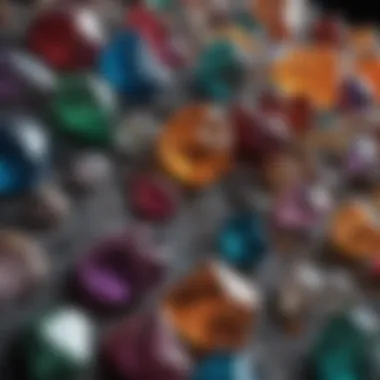

Understanding the photographic techniques relevant to crystal recognition is indispensable for both budding enthusiasts and seasoned collectors. Not only do these methods allow for a detailed examination of crystals in a two-dimensional space, but they also possess the power to reveal subtle features that may go unnoticed by the naked eye. The magic of photography wraps around the ability to freeze time and capture the essence of a crystal in its natural glory, providing evidence for identification and a beautiful addition to any collection.
Essential Equipment for Photography
When embarking on a photography adventure with crystals, the selection of equipment is paramount. Though one can rely on a smartphone, the capture quality may be a gamble. Instead, it's wise to opt for a DSLR or mirrorless camera for its versatility and superior image clarity. Factors like the sensor size, interchangeable lenses, and manual controls can dramatically influence your outcomes.
Here’s a brief list of essential gear:
- Tripod: Provides stability and reduces blurriness from shaking hands.
- Macro Lens: Perfect for close-up shots, capturing fine details and textures.
- Remote Shutter Release: Reduces camera movement during the shutter press.
- Lens Cleaning Kit: Keeps your equipment spotless for the sharpest images.
Lighting Considerations
Lighting can make or break a photograph, especially when working with crystals that can reflect and refract light in mesmerizing ways. Natural light is often preferred for its soft and flattering qualities, but it can be a fickle friend. Overcast days often provide the ideal conditions, diffusing light evenly and eliminating harsh shadows.
For those willing to explore artificial lighting, here are a few techniques:
- LED Lights: Offer a consistent, adjustable light source.
- Diffusers: Soften the light to reduce glare and hotspots on shiny surfaces.
- Reflectors: Bounce light back onto the crystal to enhance color and details.
Remember to experiment with different angles and intensities; the way light dances across a crystal can reveal hidden facets.
Capturing Details: Focus and Angles
When it comes to photography, the devil is in the details. Focusing on the right parts of a crystal, while considering the angles, is crucial for effective identification. Using a macro lens allows one to get up close and personal with the subject, showcasing intricate surface features. Keep in mind the depth of field; a shallow depth can isolate the crystal but may blur the background, creating a stunning effect.
In terms of angles, take this into account:
- 45-Degree Angle: Excellent for showing off the crystal's depth and shine.
- Direct Overhead: Useful for capturing symmetrical forms, revealing the shape at its best.
- Side Angles: Can highlight inclusions and surface details that are otherwise lost.
"Photography is the story I fail to put into words." This reflects the importance of visual representation in the identification of crystals, where each snap tells a different part of the story.
Working with these photographic techniques not only enhances your recognition skills but also allows you to expand your creativity, adding an artistic flair to your crystal identification journey. With practice and patience, one can become adept at capturing the splendor of these natural wonders.
Interpreting Crystal Images
Interpreting crystal images is a pivotal piece of the puzzle in identifying crystals visually. This section emphasizes the significance of understanding various aspects of crystalline characteristics that come alive when scrutinized through images. Crystals often exhibit their unique identities through intricate visual markers that tell a story about their structure and origins. For a collector or enthusiast, being able to interpret these images can enhance their understanding and appreciation of the mineral world.
Analyzing Color Patterns
The color of a crystal can be a straightforward yet multifaceted identifier. It's of utmost importance to note that color is not always straightforward. Many crystals present a diverse array of hues due to the presence of trace elements, defects in their structure, or the ways in which light interacts with them. For instance, an amethyst can range from pale lavender to deep violet depending on its iron content and exposure to radiation.
When examining color patterns, consider the following:
- Homogeneity: Is the color consistent throughout, or does it vary?
- Zoning: Are there noticeable bands of colors, indicating growth lines or changes in mineral composition?
- Pleochroism: Some crystals show different colors when viewed from different angles. For example, cordierite can appear bluish from one perspective and reddish from another.
Understanding these factors can help differentiate between similar-looking minerals, aiding in accurate identification and classification.
Evaluating Shape and Form
The shape and form of crystals, often referred to as habit, play a significant role in visual identification. Each mineral crystallizes in specific geometric forms influenced by its internal structure and growth conditions. For example, quartz typically exhibits a hexagonal shape, while calcite may present itself in rhombohedral forms.
Key aspects to observe when evaluating shape and form include:
- Crystal System: Determine if the crystal fits into a specific system like cubic, tetragonal, or monoclinic. Understanding these systems can help narrow down options considerably.
- Termination Faces: Are the ends pointed, flat, or complex in design? This can reveal insights into the growth environment.
- Twins: Some crystals may have twin formations, which can confuse identification at first glance. Familiarity with these formations can clear up potential misidentifications.
Recognizing these various characteristics can create a clearer path to identification, bringing rich insights to even the most seasoned collector.
Recognizing Surface Features
Surface features, such as striations, etchings, or pitting, can offer critical clues about a crystal's identity and origin. These characteristics can signal factors like weathering or particular growth patterns that are unique to certain minerals.
When identifying surface features, consider:
- Striations: Many minerals, like calcite or fluorite, exhibit fine lines along their surfaces. Assessing the direction and spacing of these lines can suggest specific minerals.
- Pitting: This can indicate a mineral's interaction with the environment, showing where weathering processes have taken their toll.
- Luster Variations: The surface finish can range from glassy to dull, influencing not just aesthetics but also identification strategies.
As you hone in on these surface nuances, you're likely to develop a richer understanding of your collection. Being attentive to detail might just reveal the hidden stories behind each specimen.
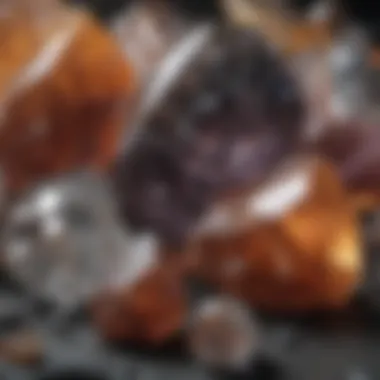
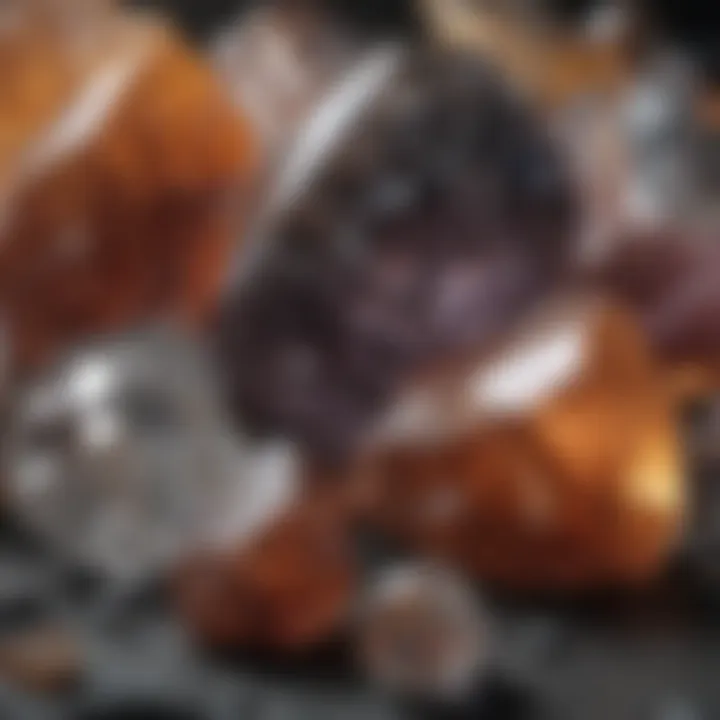
"Understanding the visual characteristics of crystals is like solving a mystery; every detail could be a clue to identification."
Interpreting crystal images is not merely an academic exercise; it’s a pathway to deeper appreciation. By mastering color analysis, shape evaluation, and recognizing surface features, collectors will navigate the fascinating world of crystals with more confidence and competence.
Challenges in Crystal Identification
Identifying crystals through visual examination can often feel like searching for a needle in a haystack. Many factors contribute to the complexities of this task. Having a clear understanding of the challenges faced during identification can empower collectors and enthusiasts alike, helping them navigate the often murky waters of crystallography with relative ease. Let's dive into some of the key hurdles one may face and why it’s essential to recognize and address them.
Common Misidentifications
One of the most prominent hurdles in crystal identification is the frequent misidentification of specimens. Crystals can often look strikingly similar to their counterparts, leading many to mistakenly categorize one crystal as another. For instance, quartz and calcite can appear quite alike, particularly in their transparent forms. The key, however, lies in knowing what to look for. Here are a few common examples of misidentifications:
- Calcite vs Quartz: Calcite is usually softer and can fizz when in contact with weak acid, while quartz will not react in the same way.
- Fluorite vs Apatite: The color can vary, and while both show fluorescence, their hardness differs.
- Selenite vs Gypsum: Selenite appears as clear or translucent crystals, often mistaken for pure crystalline forms of gypsum.
The consequences of misidentifying a crystal can be significant, especially for collectors looking to assess value or authenticity. Collectors not only risk devaluing their collection, but may also miss out on understanding the unique attributes and the intrinsic charm that each crystal holds.
The Impact of Impurities
Another significant challenge in crystal identification comes from impurities that can influence both the appearance and properties of a crystal. These impurities may alter the color, clarity, and even the hardness of a crystal, making identification more difficult. For instance, a pure amethyst has a distinct purple coloration, but inclusions of other minerals can make it look vastly different. Here are some ways impurities can impact crystal identification:
- Color Variations: Impurities can cause unexpected color changes, masking the true identity of a crystal. For example, the presence of iron in quartz can create smoky quartz, while manganese can give rise to amethyst.
- Structural Distortions: The presence of foreign elements may disrupt the crystal lattice, leading to unique shapes and surfaces that can otherwise confuse the identification process.
- Surface Irregularities: Many crystals exhibit unique surface features, but impurities can lead to irregular textures or coatings, hiding key indicators that could assist in identification.
Ultimately, the impact of impurities emphasizes the importance of careful observation. Relying solely on visual cues without taking into account these imperfections can lead to incorrect conclusions about a specimen's identity.
In the journey of crystal identification, knowledge of the common pitfalls is invaluable. Every misstep is a chance to learn.
By understanding these challenges, crystal collectors can cultivate a more discerning eye, raising both their competency and confidence in identifying beautiful specimens with precision.
Best Practices for Crystal Collectors
When it comes to crystal collecting, just having a pretty rock isn’t enough. It’s about the journey, the respect for the environment, and the insights gained along the way. Best practices for collectors become vital to enrich the experience and ensure sustainability. A mindful approach to collecting can foster a deeper connection to the specimens while also promoting responsible stewardship.
Ethical Collecting Guidelines
Ethics in collecting is not a mere suggestion; it’s a cornerstone, particularly in a world where natural resources can be fragile. Often, crystals are found in varying environments, some of which are delicate ecosystems. Before you head out to collect, here are some guidelines to consider:
- Research Local Laws: It’s essential to be aware of collecting regulations in your area. Many places have strict laws about what can and cannot be taken from public lands.
- Respect Nature: If you come across a crystal or mineral formation, consider whether disturbing it can harm the surrounding habitat. Take a step back and evaluate whether it’s worth the damage.
- Populate Responsibly: When collecting from sites with known mineral deposits, think about the impacts of your gathering. Leave something for others and the environment.
- Mind Cultural Heritage: Many regions have historical or sacred significance connected to certain minerals. Recognize and honor this heritage, steering clear from collecting in these areas.
By adhering to ethical collecting guidelines, you not only safeguard these beautiful resources for future generations but also cultivate a sense of community among collectors who value this practice.
Documentation and Record Keeping
Knowing what you have and where it comes from can enhance not just your collection but your understanding of crystals as a whole. Documentation is a key practice that often gets overlooked, yet it adds immense value. Consider these points:
- Origin Details: For each crystal you collect, note where it was found. Specific locations can add context and significance to your pieces.
- Photographic Records: Take pictures of your specimens from various angles. It helps create an archive that’s visual and informative for future reference.
- Condition Reports: Maintain notes on the condition of each specimen. Noting any scratches, chips, or other features helps you track its wear over time.
- Personal Reflections: Document your thoughts and feelings about each crystal. This can include memories linked to your collecting journey or what you learned about that specific piece.
"Well-documented information about your specimens theives knowledge, engages curiosity, and enriches the value of your collection."
In sum, thorough documentation paired with ethical practices can transform a simple hobby into an immersive study, building not just a collection, but also a narrative that reflects your growth and understanding. They say knowledge is power, and in crystal collection, that is undeniably true.
Epilogue and Future Directions
The exploration of crystal identification through visual means serves as both a fascinating endeavor and a practical skill for collectors and enthusiasts alike. Understanding crystals’ physical properties and how to visually interpret them not only elevates one’s appreciation of these natural wonders but also deepens the ability to discern between various minerals effectively. Considering the involvement of numerous diverse factors—like color variations, surface features, and structural nuances—it's clear that visual identification requires both knowledge and practice.
The Evolution of Crystal Identification
Over the years, the methods of identifying crystals have seen remarkable advancements. In earlier times, collectors relied on rudimentary, often anecdotal knowledge passed down through generations. This was an era dominated by subjective observations, which sometimes led to misconceptions about certain minerals. Today, however, with the rise of digital technology, resources like online databases and mobile applications have transformed identification practices.
For instance, enthusiasts can now access platforms like Wikimedia or the Mineral Database for detailed information on specific crystals, a step that has added precision to the identification process. Additionally, advanced photographic methods allow for high-resolution images, enabling more accurate analysis. Furthermore, the community has started to embrace scientific approaches, often incorporating spectroscopic techniques like infrared spectroscopy.
As the field continues to mature, it’s likely we will witness even more sophisticated tools and methods. Such progression reflects a broader shift towards integrating both traditional methods and modern technology, enhancing how we approach crystallography and identification techniques.
Encouraging Community Participation
Communities play a significant role in fostering knowledge around crystal identification. Online forums and social media groups have emerged as crucial platforms where enthusiasts can exchange experiences, share images, and offer advice. Participating in these networks not only enriches individual collectors' knowledge but also contributes to a collective wisdom that can aid in identification efforts.
Collectively, the integration of different experience levels can empower novice collectors and provide them guidance from seasoned veterans. Engaging with community-led projects—like group identification sessions or challenges—can serve to demystify crystals and make the learning process enjoyable.
Throwing light on community involvement also leads to a notable benefit: collaboration among members can help address common misidentifications. When crystal collectors come together, they not only enhance their knowledge but also build networks that can lead to future discoveries.
"We are only as strong as we are united; as weak as we are divided." - J.K. Rowling
In summary, the path forward for crystal identification lies not just in personal skill development, but in the collective growth of a supportive community dedicated to sharing knowledge. In this evolving landscape, every contribution matters, ensuring both the retention and dissemination of information crucial for the coming generations of collectors.



